As the annual Italian summer holiday has been cut, for many, from the entire month of August to just a few days due to dwindling savings and high unemployment, one might be forgiven for asking: what happened to la bella vita? Or indeed to the utopic vision of a country founded upon the right to work?
Utopia – and particularly its elusiveness – was the theme of an exhibition held recently in the town of San Mauro Cilento, in Salerno. The show, organised by Milan’s Isola Art Center in collaboration with local arts association CreativeOlive, marks the beginning of ongoing research by the former group into a political notion that was once the motor of change – for both good and bad – but that has now become an ideological relic. The question asked here is what might be gained by looking back from our forlorn times to a time when people looked forward to utopia.
More than 50 artists, activists and theorists were involved, alongside the general public, in the exhibition – which spanned the hillside town looking onto Salerno’s idyllic beaches – and its five days of opening events, which included debates, performances and a ‘Solar Cloud’. This last work, by Serbian artist Nikola Uzunovski, comprised an amorphous, near elliptical three-dimensional form made of plastic sheeting, see-through on top, to let the sun in, and black in its interior, to capture the rays. When placed in the midday sun, tethered to the ground by ropes upon a rooftop, the heat generated inflated the form, thereby creating a sun-fuelled flying inflatable object. One can imagine endless uses for such technology, though as ‘art’ it perfectly defines our historical relationship with utopia as a phenomenon sustained by its own hype. Like a folly, or indeed like art itself, its actual promise is never delivered upon.
Other artists and collectives involved included BAD Museum, Zanny Begg, Angelo Castucci, Gruppo Etcetera, Maddalena Fragnito, MACAO, Nikolay Oleynikov and Steve Piccolo, Edith Poirier and Camilla Topuntoli. Contributions ranged from painting, video and installation to print and musical laboratories and a museum dedicated to Situationism located in a disused olive oil press. The latter work, curated by BAD Museum – an independent space dedicated to social art on the periphery of Naples – placed this project in a historical context. The history of utopia – or the lack thereof – is a history of a costly failure to monopolise on the promise of a brighter future. Art’s most incendiary political moment was in Paris in 1968, when the Situationist International threatened to blend their anarchic rhetoric with the power of the Communist International. In the end the Situationists were just too far from public sentiment, and the movement fragmented. In this light Isola Utopia has done well to involve the public in the start of a slow process of investigation into what might be if we could turn dreams into political reality.
Zanny Begg’s painting (one of three mounted on a terrace house, with permission of its inhabitants), depicting Vladimir Tatlin’s famous model for a Monument to the Third International (1919), clearly expressed the difficult task for the Isola Art Center as it prepared to take the project to Riga in September. In Begg’s Monument to the III International (2014) the viewer can see two small stick figures depicted in conversation at the top of Tatlin’s never-realised spiralling monument. One says, ‘What a pity: What a pity a deadend: It’s such a long way down’. The other replies, ‘We could just jump’. It remains to be seen if such cynicism can find a convincing counterbalance within the artworld.
This article originally appeared in the October 2014 issue
